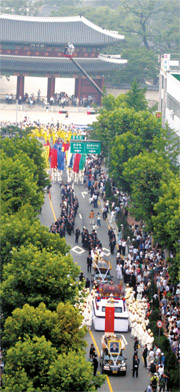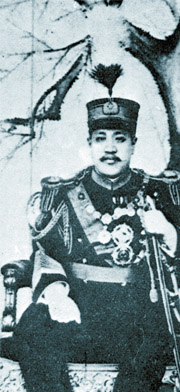Indifference surrounds royal family

The funeral procession of Lee Gu leaving Changdeok Palace in 2005. [JoongAng Ilbo]
For the past three years, he has been gathering material on customs of the royal house such as ceremonies and artifacts while talking to academics to search out remnants of his family’s glorious but forgotten past. Earlier this month, he submitted an application asking the city of Seoul to approve the establishment of a corporation aggregate that he has yet to name. Interestingly, he claims he is not out to start a revolution.
“What I want is just a formal body under which the cultural contents of the royal house are preserved so that they can be passed down to other generations because the royal family is a part of our history,” Lee said. “That’s what the government should be doing. Not an individual,” he added with a bitter tone. Three years ago, Lee Gu, the last living descendant of Lee Eun (Crown Prince Yeongchin), half brother to Lee Kang, the heir apparent to the throne and Lee Won’s uncle, passed away without a son. Through a clan consensus, Lee Won was posthumously adopted by Lee Gu, a move approved by the dead royal before he died, to keep the line of descent intact.
As he began the three-year mourning period, as dictated by tradition, Lee Won started to solidify the idea of organizing a process through which all that is left of the royal house can be opened up to the public. “As I got more involved in family affairs and the funeral I started to realize that I was part of a tradition that should not be only mine but also that of the public,” the royal descendant said.

Sunjong, last king of the Korean Empire. [JoongAng Ilbo]
Considering how the country proudly advertises a history of 5,000 years and despite the fact that a tenth of that history belongs to the Joseon Dynasty, those who dream of restoring at least a fraction of the past glory are surprised by how little interest the government has shown for such efforts. “There are royal descendants still alive but nobody cares,” complained Koh Min-hui, an official of the Imperial House Culture Foundation. Lee Won said that he has been contacting government officials at the Culture Ministry but the reception his idea has received has been lukewarm at best.
What one Culture Ministry official said reflects the harsh reality that royal descendants are facing: “It would take a lot of time and money to establish some sort of centralized body. I don’t see that happening with so much other work at hand,” said the official, declining to be named.
While other royal houses around the world, like the very much intact British monarchy, have hordes of scholars and paparazzi following their every move, apart from history textbooks that tell about the plight of the Joseon Dynasty, there is no real public interest here about the descendants of the royal house.
In 2005, “Gung (The Palace),” a TV drama depicting the life of the monarchy in modern Korea, gained huge popularity but no real political drama unfolded. Two organizations to preserve the royal tradition have emerged on the Internet, but activities do not extend much further than the bounds of cyberspace. One such group is the Society for the Restoration of the Korean Royalty, which hopes to restore the royal house as a symbolic figurehead of the state. While these groups claim to have a membership of a few thousand people each, there are far fewer active members, officials say. Lee Won said that he had met with such supporters but that nothing came of it. “They are mostly young people in their 20s and 30s. They offered to give us public support but no money,” said Lee.
Many factors have prevented the efforts of the royal family from bearing fruit, and they are not limited to the Korean War and the country’s rapid growth. Internal struggles among the royal descendants have also caused problems.
The case of Lee Hye-won is a good example. He stepped forward in the ’90s claiming he, too, carried royal blood. He said he was the son of Lee Jong, supposedly the ninth son of Lee Kang. Currently working as a researcher at the National Palace Museum of Korea, he was the only descendant who came forward for a long time after the death of Lee Kang. All other descendants had been confirmed immediately after Lee Kang’s death in 1955, when his legal wife called a gathering of family members to sort out the complex family tree. Lee Hye-won has been asked by other family members to take a DNA test, which he has refused. “I know who I am. Taking the test itself is an admission of guilt,” he said.
For some, Lee is just an impostor trying to get a free ride. “Nobody has heard of him or Lee Jong, who he claims was one of the sons of Prince Uichin. There are no records,” said Jang Young-il, the chairman of the Imperial House Culture Foundation that supports Lee Seok, one of the original 12 sons who was initially identified along with nine daughters.
Then there is friction among supporters about who should be considered the main descendants. Setting the pecking order would be important if by some miracle the royal house were to be restored and a king named.
Jang argued that the legitimacy of the heirs needed to be established first. “It’s good to have various groups supporting the descendants of the royal family, but not everyone can claim to be part of the main line of descent.”
Lee pointed out that Lee Gu, who named Lee Won as his heir, was the son of Lee Eun. But Lee Eun had married Lee Bang-ja, a Japanese royal. “That bloodline has been tainted by the Japanese. We think there is a big question mark in terms of legitimacy,” Jang said.
The Syngman Rhee government’s handling of the royal house’s belongings have also posed quite the conundrum. In the 1950s, the Rhee administration attached possessions of the royal house to the National Treasury. Rhee, the first president of the republic, had ample time to cement power and viewed the royal house as a threat to such efforts. A special committee in charge of royal assets, which included vast swaths of real estate, sold the possessions under the pretext of securing funds to protect cultural assets. Scholars say that the government’s systematic approach left nothing.
“Land was very cheaply sold to people close to President Syngman Rhee and the following administrations were afraid that digging up such shady deals would open a Pandora’s box,” said Ahn Cheon, a history professor at Seoul National University of Education. A suspicious fire in 1960 at Changgyeong Palace, home of the special committee, erased all records of the royal assets, making it impossible to trace anything that still might be out there. The police failed to catch anyone connected to the fire.
For some time, royal descendants lived on government-provided stipends. Until the administration of Park Chung Hee, some descendants were even allowed to live in parts of the royal palace. However, in 1979, Chun Doo-hwan forced out all royals still living in the palaces after seizing power in a coup d’etat. It is thought that many moved abroad to the United States or South America, where they still live today.
“The military police came and shipped us out in trucks. Our last shred of dignity was taken away,” said Lee Seok, who still remembers that day vividly. Four sons and five daughters with royal blood are still alive today.
Still, an oft-disputed issue among historians is how the last years of the powerless dynasty unfolded. King Gojong was forced by Japan to step down in 1907. The dethroning was the result of a failed attempt to send a secret mission to an international peace conference at The Hague, the Netherlands, to inform other nations that the Japan-Korea Protectorate Treaty of 1905 was signed under pressure without the consent of the king or the nation as a whole. Gojong’s second son, Sunjong, stayed in power for only three more years before announcing in August 1910 that the country had conceded all of its ruling power to Japan.
Today, all that is officially left of the royal house are five palaces and 13 royal tombs that are managed by the government’s Cultural Heritage Administration. Royal descendants like Lee Won insist they do not live in the past but only want to be acknowledged as part of the country’s old tradition.
“It’s a shame that there is no coherent effort to collect every aspect of the royal house and shape it into cultural content that can be used as a prime tourism attraction,” said Lee, who even suspected a conspiracy is at play. “There are forces out there that don’t want this to happen.”
If only anyone cared.
By Brian Lee Staff Reporter [africanu@joongang.co.kr]










with the Korea JoongAng Daily
To write comments, please log in to one of the accounts.
Standards Board Policy (0/250자)